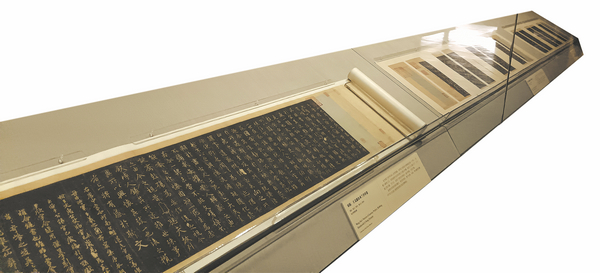

Founded in 1971 with the support of the late HK philanthropist J. S.Lee (1915-2007), the museum aims to serve the university community and the island by collecting, preserving, researching and exhibiting artifacts from ancient and premodern China.
Addressing the exhibition's opening ceremony on Sept 15, Rocky S.Tuan, vice-chancellor and president of CUHK, said, "For 60 years, CUHK has consistently placed great importance on traditional Chinese culture and humanistic values. We have upheld the mission to combine tradition with modernity, and to bring together China and the West."
On loan for the first time, the rubbings from CUHK's collection had been donated to the university's Art Museum by J. S. Lee, whose son Chien Lee was in Beijing on Sept 15.
"Unlike his siblings, my father didn't go to study overseas. Instead, he spent his time at the Yenching University in Beijing, where he acquired an enduring passion for premodern Chinese art and made lifelong friends with people whom he later joined in his collecting efforts," said Chien Lee.
One of those friends was J. S. Lee's Yenching University alumnus and Hong Kong-based banker-collector J.M. Hu (1910-93), whose donations of porcelain and other ancient Chinese artifacts today fill an entire gallery at the Shanghai Museum.
In 1975, Hu donated a Song Dynasty rubbing of a second-century stone inscription titled The Stele of Huashan Temple to the Palace Museum. In the current exhibition, it was reunited with another Song rubbing of the same inscription, which, thanks to the late Lee, entered the CUHK Art Museum upon its founding in 1971.
"The stone itself was destroyed during the Ming Dynasty (1368-1644)," said Shi Anchang, a highly regarded expert in rubbings from ancient China. "Today, there are only four existing rubbings, including the two showcased here, an additional one from the Palace Museum dated to the early Ming era, and a last one, also from the Song era, that is held at the Calligraphy Museum in Tokyo."
In 1975, Shi's mentor Ma Ziyun (1903-86) traveled to receive the precious gift from Hu.
"What we have here is not just a showcase of the beauty of ink and paper, the art of calligraphy, engraving and rubbing, but also the telling of stories steeped in cultural pride and communal spirit," said Wang Xudong, director of the Palace Museum.
Contact the writer at zhaoxu@chinadaily.com.cn